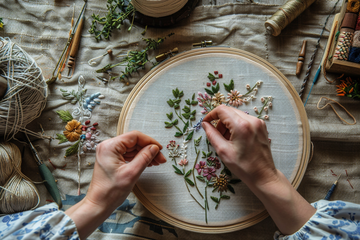Embroidery on Different Fabrics: Tips for Working with Linen, Cotton, and More
Jul 26, 2024
Embroidery is a versatile craft that can be applied to a variety of fabrics. Each type of fabric presents its own set of challenges and opportunities. Understanding how to work with different materials can enhance the quality of your embroidery and expand your creative possibilities. Here are some tips for embroidering on linen, cotton, and other popular fabrics.
Linen
Linen is a popular choice for embroidery due to its durability and natural texture. It is perfect for both detailed and simple designs.
- Preparation: Pre-wash linen to remove any sizing and to prevent shrinkage. Iron the fabric to create a smooth surface.
- Needle and Thread: Use a sharp needle to penetrate the tight weave of linen. Choose a thread that complements the texture of the fabric, such as cotton or silk embroidery floss.
- Stabilizing: Linen can be slippery, so use an embroidery hoop to keep the fabric taut. This helps maintain even stitches and prevents puckering.
- Stitches: Linen works well with most embroidery stitches. Backstitch, satin stitch, and French knots are particularly effective on this fabric.
Cotton
Cotton is one of the most common fabrics for embroidery, known for its versatility and ease of use. It is suitable for beginners and advanced embroiderers alike.
- Preparation: Always pre-wash cotton to avoid shrinkage and to remove any chemical treatments. Press the fabric to ensure it is smooth.
- Needle and Thread: Use a standard embroidery needle and cotton embroidery floss. The smooth texture of cotton allows for a variety of thread types.
- Stabilizing: An embroidery hoop is essential to keep the fabric tight. This prevents distortion and ensures neat stitches.
- Stitches: Most stitches work well on cotton. Running stitch, stem stitch, and chain stitch are commonly used for creating various designs.
Silk
Silk is a luxurious fabric that can add elegance to your embroidery projects. It requires careful handling due to its delicate nature.
- Preparation: Handle silk with care to avoid snagging. Pre-wash is optional, depending on the type of silk. Press gently to smooth out any wrinkles.
- Needle and Thread: Use a fine, sharp needle to avoid damaging the fabric. Silk thread is ideal, but cotton floss can also be used.
- Stabilizing: Use a hoop to keep the fabric taut. Consider adding a lightweight stabilizer to prevent slipping.
- Stitches: Opt for fine, delicate stitches like split stitch, stem stitch, and tiny French knots to complement the fabric’s texture.
Denim
Denim is a sturdy fabric, making it a great canvas for bold and creative embroidery designs.
- Preparation: Pre-wash denim to soften the fabric and prevent shrinkage. Iron to smooth out any creases.
- Needle and Thread: Use a heavy-duty needle suitable for thick fabric. Cotton floss or even thicker threads can be used to stand out against the denim.
- Stabilizing: A hoop is useful, but not always necessary if the denim is stiff enough. Stabilizers can help if the fabric is particularly stretchy or worn.
- Stitches: Bold stitches like chain stitch, satin stitch, and even appliqué work well on denim. Consider using colorful threads to create striking designs.
Velvet
Velvet adds a rich, luxurious feel to embroidered projects but can be challenging due to its pile.
- Preparation: Avoid pre-washing to preserve the fabric’s texture. Handle carefully to avoid crushing the pile.
- Needle and Thread: Use a sharp needle and silk or rayon thread to minimize damage to the fabric.
- Stabilizing: Use a hoop and a stabilizer to keep the fabric taut. Place a piece of tissue paper or water-soluble stabilizer over the velvet to prevent the pile from being crushed.
- Stitches: Use simple stitches like running stitch and stem stitch. Avoid heavy stitching that can flatten the pile.
Tips for All Fabrics
- Test Swatches: Always test your stitches on a small piece of fabric before starting on your main project. This helps you adjust tension and choose the right needle and thread.
- Hoop Tension: Ensure the fabric is taut but not overstretched in the hoop. Too much tension can distort your design.
- Finishing: Once your embroidery is complete, press the fabric from the back side using a pressing cloth to protect the stitches.





